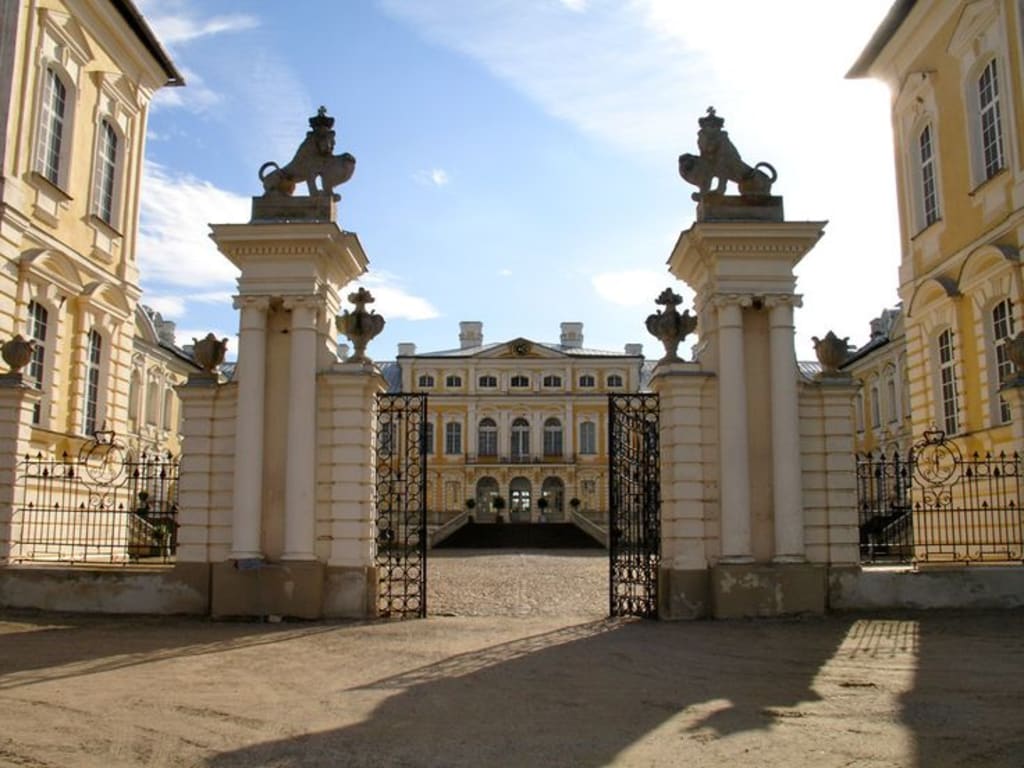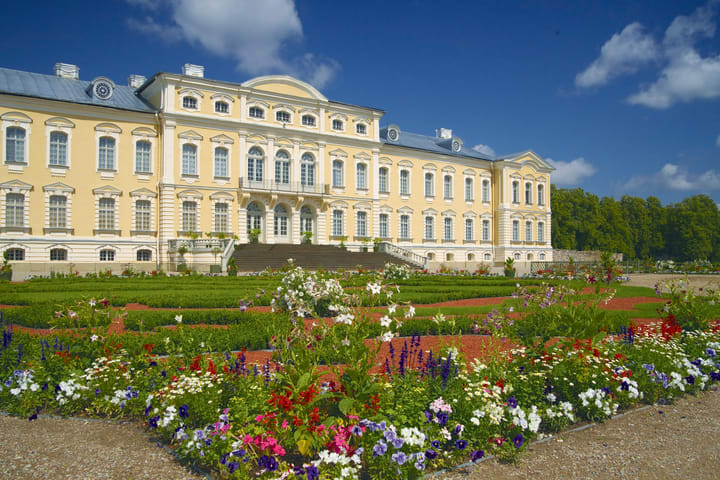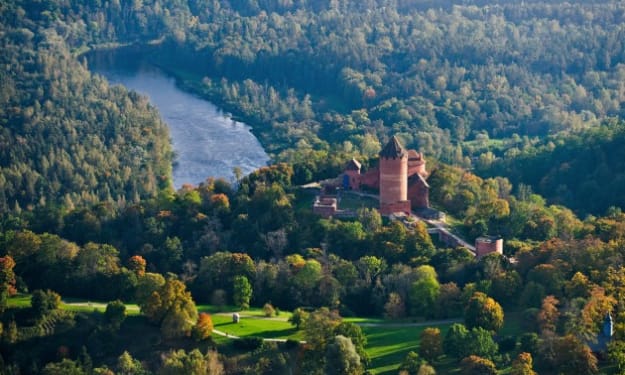Majestic Rundales Palace
A Baroque-Style Palace

This is a beautiful and magnificent Baroque style palace located in Latvia in the Rundales district Pilsrundale. It was designed by a Russian architect of Italian descent Francesco Bartolomeo Rastrelli. It took from 1736 to 1768 to build this castle and it became the summer residence of the Kurzeme (this region was also known as Courland, so Biron was called the Duke of Courland) region, Duke Ernst Johann von Biron. Within Rundales Palace territory there are also many additional buildings and a large park. Since 1972 the Rundales Palace Museum can be visited and there have been many restorations done on this castle to make it look like it did in the 18th century.
Fascinating History
Actually, at one time, there had been a Middle Age castle which stood in the place where Rundales Palace now stands. The palace took 32 years to build because when Russia took over the rule of the Kurzemes and Zemgales regions in 1740, Duke Biron was arrested and deported to Siberia. Upon his return in 1762, the work on the castle was continued. During the time that Kurzeme and Zemgale once again became part of the Russian Empire in 1795, Rundales Palace went to Catherine II of Russia who was also known as Catherine the Great, and she in turn gave it as a gift to Prince Platon Zubov’s younger brother, a Russian general who led the Persian Expedition of 1796 Count Valerian Zubov.
After Russian Emperor Paul I came to rule, Count Zubov was dishonored and he spent a great deal of his time at Rundales Palace. When Emperor Paul I was killed in 1801, Count Zubov began holding a lot of great balls at the palace. At the Harvest Ball in 1802 there were known to be 1200 guests. After Count Zubov’s death in 1804, the castle went to his brother Platon Zubov. During the Russian-French War in 1812, Rundales Palace became an army hospital for the army of Napoleon I and in the castle’s park there are many soldiers buried for whom now there is a monument built to honor them in a corner of the garden.
While Platon Zubov lived in Rundales Palace in 1814 he married a Lithuanian landowner's daughter Tekla, and after Zubov died in 1822, Tekla remarried. Her new husband was Count Andrei Shuvalov and they lived in the castle until the end of the 19th century. During WWI, Rundales Palace was used by the German Army and the Bermont Army. After the war the palace was in the hands of the Ministry of Agriculture and in the castle a school was established and a part of it was also the residence of veteran soldiers. In 1924 it was included in the list of National Monuments and in 1932 it passed into the hands of the Ministry of Education and was rebuilt for use as a school. After WWII the palace was used for grain warehouses and after the war the school took over the warehouses and it remained as a school until 1978. Other changes that Rundale went through was that in 1963 a part of it was taken over by the Museum of Regional Studies and Art of Bauska which opened one of their branches there. In 1972 it became a museum and the castle park was designed. To become a worthy tourist attraction in 2006, the European Union gave 1,342,346 Lats for its total reconstruction.
Gold Hall

Italian masters from St. Petersburg Francesco Martini and Carlo Zucchi created paintings on the castle ceilings and walls and sculptor Johann Michael Graff from Berlin made stucco decorations on the background of artificial marble. On the property are also stalls for horses and a carriage court. The park spreads out to the south of the palace. In part of the palace garden is a French garden in which part a rose garden was planted. In front of the palace are water basins – the central pool is enclosed by four ornamental parterres and the surfaces are covered with chips of black and white marble and the lawn has boxwood hedging. Around the park runs an artificial canal and beyond the canal is a hunting park which consists of a forest.
Ceiling Painting

Flower Gardens

Hunting Park

Various tours are available for tourists. They may see the staterooms and the Duke’s former living quarters and his staterooms this is known as the short route. If they wish to take the long route they may see the staterooms, the Duke’s living quarters and staterooms, the Duchess’ apartments and the exhibition, ”Seventeenth to Nineteenth Century Fashion in Latvia.” They may tour the gardens free of charge.
The Ghosts of Rundales Palace
The daughter of Count Shuvalov’s family doctor died. There was no funeral and the doctor died without having had the time to look into his daughter’s death. There was an unusual problem about burying the daughter. While the doctor was still alive he told everyone that his daughter had gone on a trip, but he actually had hidden her in the palace’s basement. Since this time, supposedly her spirit walks about Rundales Palace in a white gown and asks passers-by to bury her so her soul can rest in peace.
Among the happenings that have been witnessed, a worker who was helping to restore the palace suddenly felt an unseen hand remove his glasses and saw the glasses floating away. He ran from the palace never to return. When the palace still had a school there, a woman was cleaning the floors when she heard a sound against the window pane. She paid no attention. Then she felt someone tug at her skirt and a voice whispered for her to go away. She figured she was imagining things and continued cleaning. Her skirt was tugged a second time and again she heard someone whisper go away only a bit louder. Suddenly the woman couldn’t move and then there came a stronger tug and a very loud voice shouted telling her to go away. That got the woman moving; she ran from the classroom and in the hallway. A woman dressed in white passed her by. The ghostly woman quietly drifted to the end of the hall and lifted the lid from the student’s water bucket and spit in it. Afterward, the cleaning woman doesn’t recall how she got home.
Rundales Palace tour guide Benita Spale tells her story. Since restoration was going on some rooms were missing their doors. One doorway had a frame encased in a plastic sheet so that the doorway could be closed. The frame had brackets which connected them to the palace alarm system Benita was making the rounds one evening checking out the palace’s signalization system. She came to this doorway and carefully closed the frame, it swung open again she swung the doorway closed, again and again, it swung open. Then she felt a tug on her skirt. This time the unseen holder didn’t let go of her skirt and with difficulty, she pulled her skirt out of the unseen grasp. Down the steps, Benita ran. Guards downstairs seeing how frightened she was inquired what had happened. Of course, when they went upstairs, there was no one there.
About the Creator
Rasma Raisters
My passions are writing and creating poetry. I write for several sites online and have four themed blogs on Wordpress. Please follow me on Twitter.






Comments
There are no comments for this story
Be the first to respond and start the conversation.